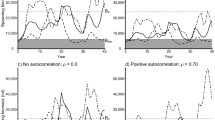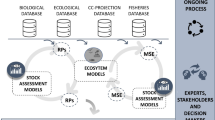Abstract
The linear equations that describe trophic fluxes in mass-balance, equilibrium assessments of ecosystems (such as in the ECOPATH approach) can be re-expressed as differential equations defining trophic interactions as dynamic relationships varying with biomasses and harvest regimes. Time patterns of biomass predicted by these differential equations, and equilibrium system responses under different exploitation regimes, are found by setting the differential equations equal to zero and solving for biomasses at different levels of fishing mortality. Incorporation of our approach as the ECOSIM routine into the well-documented ECOPATH software will enable a wide range of potential users to conduct fisheries policy analyses that explicitly account for ecosystem trophic interactions, without requiring the users to engage in complex modelling or information gathering much beyond that required for ECOPATH. While the ECOSIM predictions can be expected to fail under fishing regimes very different from those leading to the ECOPATH input data, ECOSIM will at least indicate likely directions of biomass change in various trophic groups under incremental experimental policies aimed at improving overall ecosystem management. That is, ECOSIM can be a valuable tool for design of ecosystem-scale adaptive management experiments
Similar content being viewed by others
References
Allen, K.R. (1971) Relation between production and biomass. J. Fish. Res. Bd Can. 28, 1573–1581.
Andersen, K.P. and Ursin, E. (1977) A multispecies extension of the Beverton and Holt theory of fishing with accounts of phosphorus circulation and primary production. Meddr. Danm. Fisk.-og Havunders, N.S., 7, 319–435.
Beverton, R.J.H. and Holt, S.J. (1957) On the dynamics of exploited fish populations. U.K. Minist. Agric. Fish. Fish. Invest. (Ser. II) 19, 533 pp.
Browder, J.A. (1993) A pilot model of the Gulf of Mexico continental shelf. In Christensen, V. and Pauly, D., eds. Trophic Models of Aquatic Ecosystems (ICLARM Conf. Proc. 26). Manila: ICLARM, pp. 279–284.
Carpenter, S.R. and Kitchell, J.F. (eds) (1993) The Trophic Cascade in Lakes. New York: Cambridge University Press. 385 pp.
Castilla, J.C. (1994) The Chilean small-scale shellfisheries and the institutionalization of new management practices. Ecology Int. Bull. 21, 47–63.
Christensen, V. (1995a) A model of trophic interactions in the North Sea in 1981, the year of the stomach. Dana 11(1), 1–28.
Christensen, V. (1995b) A multispecies virtual population analysis incorporating information of size and age. ICES C.M. 1995/D:8; 14 pp.
Christensen, V. (1995c) Ecosystem maturity – towards quantification. Ecol. Modelling 77, 3–32.
Christensen, V. (1996) Virtual population reality. Rev. Fish Biol. Fish. 6, 243–247.
Christensen, V. and Pauly, D. (1992a) ECOPATH II – a software for balancing steady-stage models and calculating network characteristics. Ecol. Modelling 61, 169–185.
Christensen, V. and Pauly, D. (1992b) A Guide to the ECOPATH II Program (version 2.1). (ICLARM Software 6). Manila: ICLARM. 72 pp.
Christensen, V. and Pauly, D. (eds) (1993) Trophic Models of Aquatic Ecosystems (ICLARM Conf. Proc. 26). Manila: ICLARM. 390 pp.
Christensen, V. and Pauly, D. (1995) Fish production, catches and the carrying capacity of the world oceans. NAGA, the ICLARM Q. 18(3), 34–40.
Collie, J.S. (1991) Adaptive strategies for management of fisheries resources in large marine ecosystems. In Sherman, K., Alexander, L.M. and Gold, B.D., eds Food Chains, Yields, Models, and Management of Large Marine Ecosystems. Boulder, Co: Westview Press, pp. 225–242.
Cooke, J.G. (1983) The assessment of exploited marine populations from catch data. DPhil thesis, Univ. York, UK. 437 pp.
Cushing, D.H. (1980) The decline of the herring stocks and the gadoid outburst. J. Cons. Int. Explor. Mer 39, 70–81.
Dalsgaard, J.P.T., Lightfoot, C. and Christensen, V. (1995) Towards quantification of ecological sustainability in farming systems analysis. Ecol. Eng. 4, 181–189.
Deriso, R.B. (1980) Harvesting strategies and parameter estimation for an age-structured model. Can. J. Fish. Aquat. Sci. 37, 268–282.
Fryer, G. and Iles, T.D. (1972) The Cichlid Fishes of the Great Lakes of Africa: Their Biology and Evolution. Edinburgh: Oliver and Boyd. 641 pp.
Gulland, J.A. and Garcia, S. (1984) Observed patterns in multispecies fisheries. In May, R.M., ed. Exploitation of Marine Communities (Dahlem Konferenzen, Life Sciences Research Report 32). Berlin: Springer-Verlag, pp. 155–190.
Hoenig, J.M., Csirke, J., Sanders, M.J., Abella, A., Andreoli, M.G., Levi, D., Ragonese, S., Al-Shoushani, M. and El-Musa, M.M. (1987) Data acquisition for length-based assessments: report of Working Group I. p. 343–352. In Pauly, D. and Morgan, G.R., eds. Length-Based Methods in Fisheries Research (ICLARM Conf. Proc. 13). Manila: ICLARM, pp. 343–352.
Holling, C.S. (1959) The components of predation as revealed by a study of small mammal predation of the European pine sawfly. Can. Entomol. 91, 203–320.
Holling, C.S. (1973) Resilience and stability of ecological systems. Ann. Rev. Ecol. Syst. 4, 1–23.
Hunter, M.D. and Price, P.W. (1992) Playing chutes and ladders: heterogeneity and the relative roles of bottom-up and top-down forces in natural communities. Ecology 73, 724–732.
Jones, R. (1982) Ecosystems, food chains and fish yields. In Pauly, D. and Murphy, G.I., eds. Theory and Management of Tropical Fisheries (ICLARM Conf. Proc. 9). Manila: ICLARM, pp. 195–240.
Kitchell, J.F., Eby, E.A., He, X., Schindler, D.E. and Wright, R.M. (1994) Predator–prey dynamics in an ecosystem context. J. Fish Biol. 45, 209–226.
Kitchell, J.F., Schindler, D.E., Ogatu-Ohwayo, R. and Reinthal, P.M. (1996) The Nile perch in Lake Victoria: interactions between predation and fisheries. Ecol. Appl. (in press).
Larkin, P.A. and Gazey, W. (1982) Applications of ecological simulation models to management of tropical multispecies fisheries. In Pauly, D. and Murphy, G.I., eds. Theory and Management of Tropical Fisheries (ICLARM Conf. Proc. 9). Manila: ICLARM, pp. 123–140.
Matson, P.A. and Hunter, M.D. (1992) The relative contributions of top-down and bottom-up forces in population and community ecology. Ecology 73, 723.
Moreau, J. (1995) Analysis of species changes in Lake Victoria using ECOPATH, a multispecies trophic model. In Pitcher, T.J. and Hart, P.J.B., eds. The Impact of Species Changes in African Lakes (Fish and Fisheries Series 18). London, UK: Chapman & Hall, pp. 137–161.
Ogutu-Ohwayo, R. (1990) The decline of the native fishes of Lakes Victoria and Kyoga (East Africa) and the impact of introduced species, especially the Nile perch, Lates niloticus, and the Nile tilapia, Oreochromis niloticus. Env. Biol. Fishes 27, 81–96.
Ogutu-Ohwayo, R. (1993) The effects of predation by the Nile perch, Lates niloticus L., on the fishes of Lake Nabugabo, with suggestions for conservation of endangered endemic cichlids. Conserv. Biol. 7, 701–711.
Opitz, S. (1993) A quantitative model of the trophic interactions in a Caribbean coral reef ecosystem. In Christensen, V. and Pauly, D., eds. Trophic Models of Aquatic Ecosystems (ICLARM Conf. Proc. 26). pp. 259–267.
Patterson, K. (1992) Fisheries for small pelagic species: an empirical approach to management targets. Rev. Fish Biol. Fisheries 2, 321–338.
Pauly, D. (1980) On the interrelationships between natural mortality, growth parameters, and mean environmental temperature in 175 fish stocks. J. Cons. Int. Explor. Mer 39, 175–192.
Pauly, D. (1986) A simple method for estimating the food consumption of fish populations from growth data and food conversion experiments. Fish. Bull. U.S. 84, 829–842.
Pauly, D. (1996) One hundred million tonnes of fish and fisheries research. Fish. Res. 25, 25–38.
Pauly, D. and Christensen, V. (1993) Stratified models of large marine ecosystems: a general approach, and an application to the South China Sea. In Sherman, K., Alexander, L.M. and Gold, B.D., eds. Stress, Mitigation and Sustainability of Large Marine Ecosystems. Washington, DC: AAAS Press, pp. 148–174.
Pauly, D. and Christensen, V. (1995) Primary production required to sustain global fisheries. Nature 374, 255–257.
Pauly, D. and Christensen, V. (1996) Rehabilitating fished ecosystems: insights from the past. NAGA, ICLARM Q. 19(3), 13–14.
Pauly, D., Muck, P., Mendo, J. and Tsukayama, I. (eds) (1989) Peruvian Upwelling Ecosystem: Dynamics and Interactions (ICLARM Conf. Proc. 18). Manila: ICLARM. 438 pp.
Perry, E.A. (1995) Salmon stock restoration and enhancement strategies and experiences in British Columbia. Am. Fish. Soc. Symp. 15, 152–160.
Polovina, J.J. (1984) Model of a coral reef ecosystem I. The ECOPATH model and its application to French Frigate Shoals. Coral Reefs 3, 1–11.
Pope, J.G. (1991) The ICES Multispecies Assessment Working Group: evolution, insights, and future problems. ICES Mar. Sci. Symp. 193, 22–33.
Sainsbury, K.J. (1988) The ecological basis of multispecies fisheries, and management of a demersal fishery in tropical Australia. In Gulland, J., ed. Fish Population Dynamics, 2nd edn. London: Wiley, pp. 350–381.
Sainsbury, K.J. (1991) Application of an experimental approach to management of a tropical multispecies fishery with highly uncertain dynamics. ICES Mar. Sci. Symp. 193, 301–320.
Schnute, J. (1987) A general fishery model for a size-structured fish population. Can. J. Fish. Aquat. Sci. 44, 924–940.
Shepherd, J.G. (1988) An exploratory method for the assessment of multispecies fisheries. J. Cons. Int. Explor. Mer 44, 189–199.
Sparre, P. (1991) Introduction to multispecies virtual population analysis. ICES Mar. Sci. Symp. 193, 12–21.
Stein, R.A., DeVries, D.R. and Dettmers, J.M. (1995) Food-web regulation by a planktivore: exploring the generality of the trophic cascade hypothesis. Can. J. Fish. Aquat. Sci. 52, 2518–2526.
Stewart, D.J., Kitchell, J.F. and Crowder, L.B. (1981) Forage fishes and their salmonid predators in Lake Michigan. Trans. Am. Fish. Soc. 110, 751–763.
Strong, D.R. (1992) Are trophic cascades all wet? Differentiation and donor control in speciose ecosystems. Ecology 73, 747–754.
Temming, A. (1994a) Food conversion efficiency and the von Bertalanffy growth function I: a modification of Pauly's model. NAGA, ICLARM Q. 17(1), 38–39.
Temming, A. (1994b) Food conversion efficiency and the von Bertalanffy growth function, Part II and conclusion: Extension of the new model to the generalized von Bertalanffy growth function. NAGA, ICLARM Q. 17(4), 38–39.
Walters, C. and Juanes, F. (1993) Recruitment limitation as a consequence of natural selection for use of restricted feeding habitats and predation risk taking by juvenile fishes. Can. J. Fish. Aquat. Sci. 50, 2058–2070.
Werner, E.E. and Hall, D.J. (1988) Ontogenetic habitat shifts in bluegill: the foraging rate–predation risk trade-off. Ecology 69, 1352–1366.
Winberg, G.G. (1956) Rate of Metabolism and Food Requirements of Fishes (Transl. Fisheries Res. Bd Canada 253). 202 pp. + tables.
Author information
Authors and Affiliations
Rights and permissions
About this article
Cite this article
Walters, C., Christensen, V. & Pauly, D. Structuring dynamic models of exploited ecosystems from trophic mass-balance assessments. Reviews in Fish Biology and Fisheries 7, 139–172 (1997). https://doi.org/10.1023/A:1018479526149
Issue Date:
DOI: https://doi.org/10.1023/A:1018479526149




